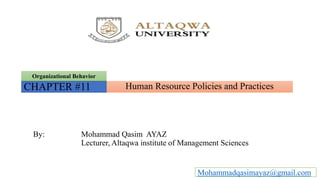
HR Policies & Practices Chapter
- 1. Human Resource Policies and Practices Organizational Behavior CHAPTER #11 By: Mohammad Qasim AYAZ Lecturer, Altaqwa institute of Management Sciences Mohammadqasimayaz@gmail.com
- 2. This Chapter Includes • Defining Human Resource Management. • Human Resource. • Humane Resource Management. • Humane Resource Main Responsibilities. • What is Recruitment? • Recruitment Process. • Stages in Recruitment Process. • Job description. • Job specification. • What is Selection? • Selection Process. • Seven stages of Selection Process. • What is Training. • Types of Training. • Induction Training. • Job Instruction Training. • On the Job Training. • Coaching. • Off the Job Training.
- 3. Defining Human Resource Management. • Human resources are the people who work for the organization. • Human resource management is really employee management with an emphasis on those employees as assets of the business. • Human Resource Management (HRM) is the term used to describe formal systems formulated for the management of people within an organization. • The process of hiring and developing employees so that they become more valuable to the organization.
- 4. Humane Resource Main Responsibilities. 1. Human Resource Management includes: 2. Conducting job analyses. 3. Planning personnel needs. 4. Recruiting the right people for the job. 5. Orienting and training. 6. Managing wages and salaries. 7. Providing benefits and incentives. 8. Evaluating performance. 9. Resolving disputes. 10. Communicating with all employees at all levels.
- 5. What is Recruitment? • Recruitment is the process of finding and hiring the best-qualified candidate (from within or outside of an organization) for a job opening in a timely and cost-effective manner.
- 8. Job Description and Job Specification • A job description outlines the primary duties and responsibilities of a given position in a company. • while a job specification outlines the qualities and qualifications required of someone in the role. Note: Both are useful in evaluating whether an applicant is a good fit for a job.
- 9. What is Selection? • The Selection is the process of choosing the most suitable candidate for the vacant position in the organization. • OR • The process of interviewing and evaluating candidates for a specific job and selecting an individual for employment based on certain criteria.
- 10. Human Resource Selection Process.
- 11. 1. Initial screening: screening interview in which those candidates are eliminated from the further selection process who do not meet the minimum eligibility criteria as required by the organization. 2. Completed Application: Once the individual qualifies the initial interview he is required to fill in the application form in the prescribed format. This application contains the candidate data such as age, qualification, experience, etc. This information helps the interviewer to get the fair idea about the candidate and formulate questions to get more information about him. 3. Employment Test: Once the applications are received, these are screened by the screening committee, who then prepare a list of those applicants whom they find suitable for the interviews. 4. Comprehensive Interview: In order to check the mental ability and skill set of an individual, several tests are conducted. Such as intelligence tests, aptitude tests, interest tests, psychological tests, personality tests, etc. 5. Background investigation: the interviewer asks questions from the applicant to discover more about him and to give him the accurate picture of the kind of a job he is required to perform. 6. Physical Examination: Here the physical and mental fitness of the candidate are checked to ensure that he is capable of performing the job. 7. Job Offer: Finally, the candidate who qualifies all the rounds of a selection process is given the appointment letter to join the firm.
- 12. Training ? • Training is teaching, or developing in oneself or others, any skills and knowledge that relate to specific useful competencies. • OR • A process by which someone is taught the skills that are needed for an art, profession, or job.
- 13. Types of Training 1. Induction training:- Also known as orientation training given for the new recruits in order to make them familiarize with the internal environment of an organization. 2. Job instruction training:- This training provides an overview about the job and experienced trainers demonstrates the entire job. 3. On-the-job training Methods:- Under these methods new or inexperienced employees learn through observing peers or managers performing the job and trying to imitate their behavior. 4. Coaching:- It helps in quickly identifying the weak areas and tries to focus on them. 5. Off-the-job Training Methods:- Off-the-job training methods are conducted in separate from the job environment, study material is supplied, there is full concentration on learning rather than performing, and there is freedom of expression.
